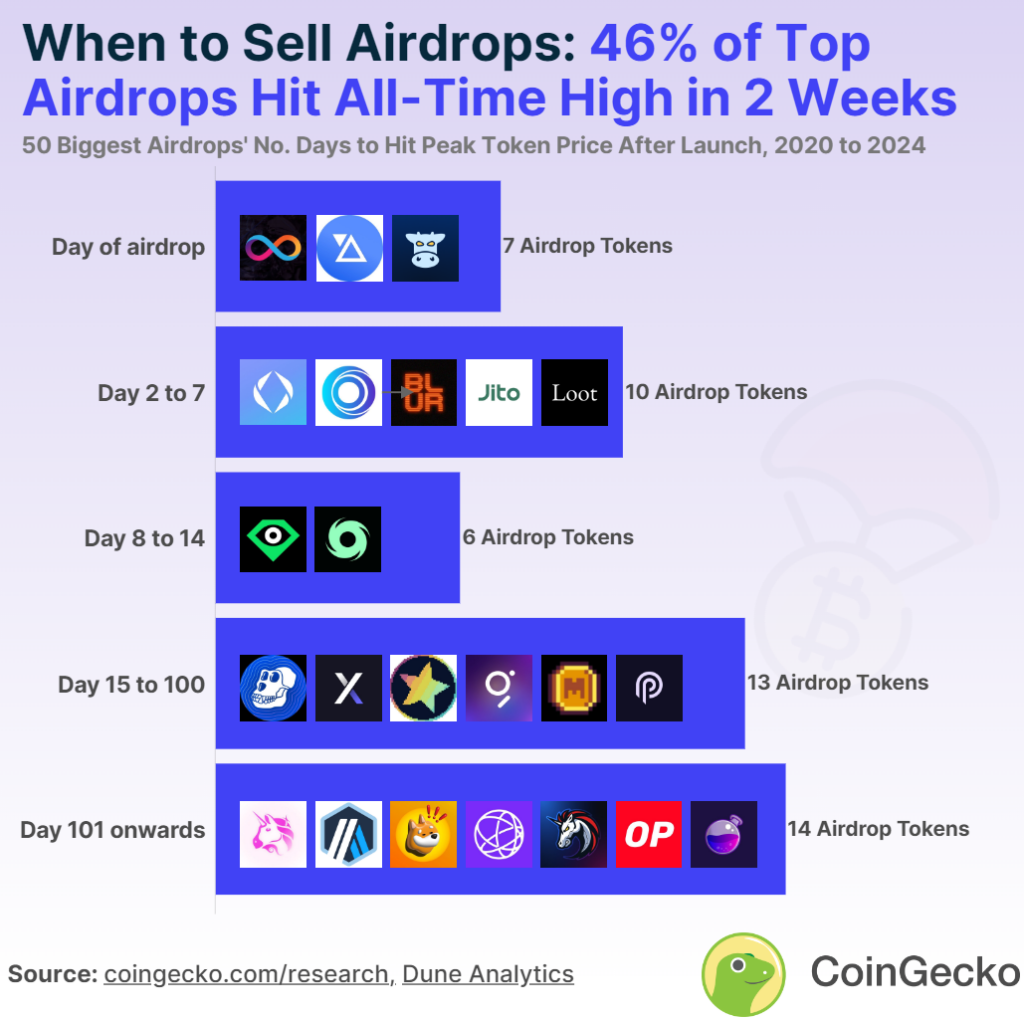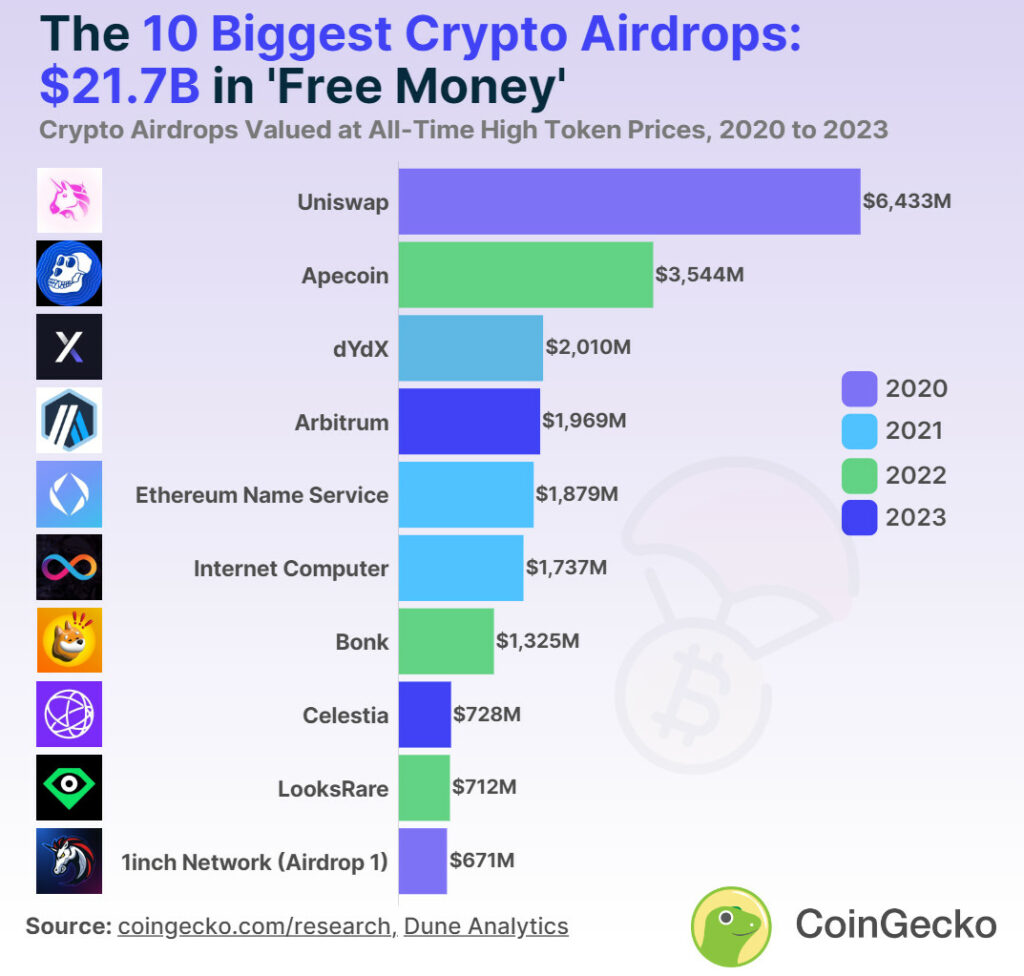Airdrops have been sharing the spotlights over the last couple of months. Quite a few projects dropped big shares to their users or testers. Jito, Celestia, Dymension, Jupiter, and a few others had juicy drops. So, first, there’s the excitement of receiving ‘free money’. But what are you going to do with it? Keep it and hodl it, or sell it? And when is the best moment to sell?
All questions that CoinGecko answered in their recent report about airdrops. So, we’re taking a closer look at this report.
Selling Your Airdrops, When Is the Best Time?
When to sell your airdrops is the big question here. When is the best time, so you can maximize your profits? Well, here’s a stunning result from CoinGecko’s report. It states that 46% of the biggest airdrops, reach their ATH within 2 weeks. That was 23 out of 50 big airdrops.
2-Week Tokens
This figure suggests selling your airdrop within 2 weeks after you receive it. This can be the key to getting the most out of your airdrop. CoinGecko’s report broke this down with some good samples. For older airdrops, here’s when they peaked:
- Ethereum Name Service, +73% after 2 days of trading.
- X2Y2, 121% by day 2.
- Blur, +90% after 6 days.
- LooksRare, no less than 192% by day 10.
- And ArbDoge AI a stunning 425% after two weeks.
Here’s a similar list for more recent airdrops. Since these tokens have a limited trading history, we need to wait and see if they can hit new ATHs.
- Jito was up by 43% on day 2.
- Wen, 37% by day 3.
- Dymension was up by 75% on day 10.
- Manta hit 72% by day 12.
- Heroes of Mavia saw a 217% increase at 13 days.
So, 16 tokens seem to have reached their peak trading times within 2 weeks after they dropped. This is also of interest to the projects that airdropped. It shows that airdropping is an effective marketing tool. Many people talk about the project after the airdrop. This tends to result in a positive price development for the token in question. See the picture below.

Airdrop Day Tokens
The other 7 tokens peaked on the airdrop day itself. The price didn’t fetch the same level, or better, as on day 1. For example, Jupiter ($JUP) started with a $0.66 price. However, ever since, it saw sideways action between $0.45 and $0.55. It hasn’t gotten back to that initial ATH yet. This is a typical scenario when airdrop receivers want to cash in immediately. As a result, there’s sell-off pressure. So, it keeps recording lows. That’s because more and more receivers start selling off their holdings.
Longer Than 2 Weeks
However, 54%, or 27 out of 50 airdrops, reached their ATHs after 2 weeks. Some took as long as 581 days to reach their ATH. For this to happen, the market should show favorable conditions. Growth of the projects also helps in this process.
What Influence Do Market Conditions Have?
That market conditions can have an impact, should come as no surprise. That’s why we will take a brief look at the last 3 years. We’ll take a look at how airdropped tokens fared during each year.
2021
This resulted in 19 of the biggest recorded airdrops having ATHs during the 2021 bull run. They dropped either before or during that bull run. As a result, the market conditions were favorable for these tokens. For example, 4 tokens hit an ATH after 100 days. These tokens are,
- Uniswap is up by a stunning 1,145%.
- 1inch did hit 216%.
- Gitcoin with 242%.
- And Bank saw a 94% increase.
These tokens saw better returns after a longer waiting period. Unlike the first two weeks of trading. For example, let’s take a look at Uniwap’s $UNI token. This did 10x better at its ATH (1145%) compared to the first two weeks of its trading (106%). So, this also shows that sometimes it’s a better strategy to hold on to your airdropped tokens. Especially if market conditions are favorable, like during a bull run.
2022
In 2022, we saw bearish market conditions. Only 11 out of the 50 tokens hit an ATH i 2022. However, in early 2022 we saw an NFT bull market. Three NFT-related tokens saw ATH in 2022, LooksRare, Apecoin, and X2Y2. All other tokens that hit an ATH in 2022, also saw their launch in 2022. Osmosis is the exception, it launched in 2021 but saw its ATH in 2022.
2023 and Early 2024
During most of 2023, we experienced a bear market. Nonetheless, 21 of the 50 tokens hit an ATH during this time frame. The end of 2023 saw a bullish sentiment developing. Another 8 tokens, out of these 21, experienced an ATH after more than 100 days.
- Arbitrum (68%).
- Bonk (28,091%).
- Celestia (777%).
- Optimism (186%).
- Aptos (34%).
- WorldCoin (249%).
- Arkham (67%).
- And Maverick (38%).
Five tokens hit an ATH between 15 and 100 days. The remaining 8 tokens hit an ATH two weeks after their airdrop. So, we can see a shift in market conditions again. With an upcoming bull run, it may be better to hold on to your current airdrops.
Source: CoinGecko
Conclusion
The CoinGecko report on when it’s the best time to sell your airdrops has some good information. One factor to consider is the current market conditions. During a bearish market sentiment, it may be best to sell your airdrop within 2 weeks. However, with more favorable conditions, like during a bullish sentiment, it may be best to hold on. The period between 15 and 100 days seems most favorable.
Disclaimer
The information discussed by Altcoin Buzz is not financial advice. This is for educational, entertainment and informational purposes only. Any information or strategies are thoughts and opinions relevant to accepted levels of risk tolerance of the writer/reviewers, and their risk tolerance may be different from yours.
We are not responsible for any losses that you may incur as a result of any investments directly or indirectly related to the information provided. Bitcoin and other cryptocurrencies are high-risk investments, so please do your due diligence.
Copyright Altcoin Buzz Pte Ltd.






























